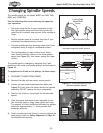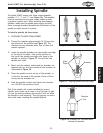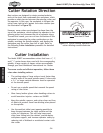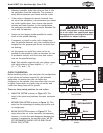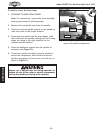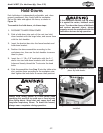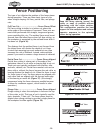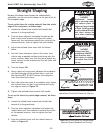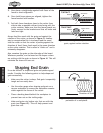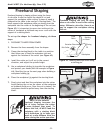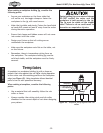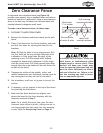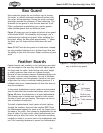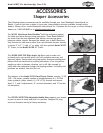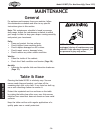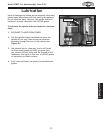
-30-
Df[\cN(/).=fiDXZ_`e\jD]^%J`eZ\*&()
FG<I8K@FEJ
J_Xg`e^<e[>iX`e
,% Now place a straightedge against both faces of the
fence to check alignment.
-% Once both fence pieces are aligned, tighten the
fence bracket lock handles.
.% Set both fence boards as close to the cutter from
side-to-side as possible without interfering with the
cutter rotation. Make sure that the fence boards are
firmly secured to the brackets and that all knobs and
locks are tight.
Always feed the wood with the grain and against the
rotation of the cutter, as shown in =`^li\+(% Another
way to conceptualize this is to always feed the wood
into the cutter so that the cutter is pushing against the
direction of feed. Never feed wood in the same direction
as the cutter rotation. This is called a “climb cut” and is
extremely dangerous.
Also, examine the grain on the side edge of the board.
Whenever possible, run the board so the shaper cutters
are cutting with the grain as shown in =`^li\+(. This will
minimize the chance of tear out.
:fii\Zk
=\\[;`i\Zk`fe
@e]\\[=\eZ\
Flk]\\[=\eZ\
N`k_>iX`e
@eZfii\Zk
=\\[;`i\Zk`fe
@e]\\[=\eZ\
Flk]\\[=\eZ\
8^X`ejk>iX`e
IfkXk`fe
IfkXk`fe
=`^li\+(% Feeding the workpiece with the
grain, against cutter rotation.
It can be difficult to shape end grain and produce good
results. Consider the following points to help shape end
grain successfully.
• Make sure the cutter is sharp. End grain is especially
tough and can easily burn.
• Use the miter gauge when shaping end grain on a
narrow workpiece to ensure the workpiece remains
stable against the forces of the cutter.
• Place a backing board behind the workpiece to
prevent tear out on the trailing edge.
• Make end grain cuts before cuts that are with the
grain (see =`^li\+)). This will help prevent end
grain tear out.
Direction of Feed
1
2
34
=`^li\+)% Sequence for cutting the full
perimeter of a workpiece.



